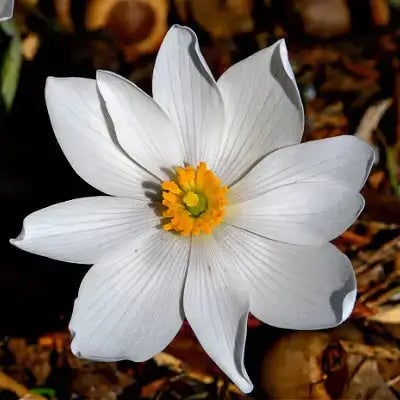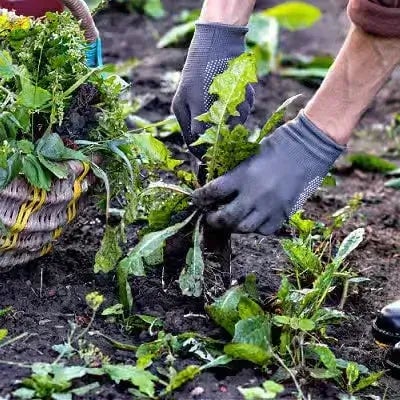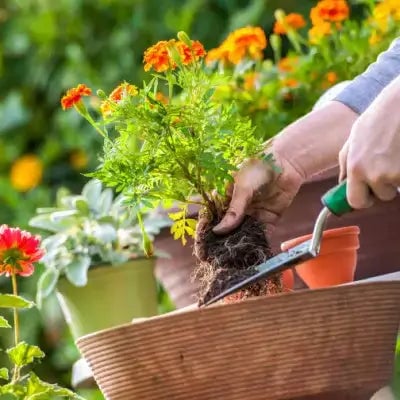Fresh flowers transform any home space by introducing nature's beauty inside living areas. To keep flowers fresh for an extended time, you need to do more than simply put them in water, regardless of whether the bouquet is homemade or professionally arranged. When flowers are cut, they start to deteriorate, but several easy methods exist to prolong their vibrancy and life span.
Proper care allows fresh flowers to remain beautiful for several additional days. The techniques work effectively with numerous flower types, such as native perennials Spot Bee Balm, White Wood Aster, and Swamp Milkweed, which serve as beautiful cut flowers and garden pollinator attractants. When you adhere to proper procedures, you can extend bouquet freshness so that the petals stay crisp and the colors remain vivid.
The initial cutting method determines how long flowers will stay fresh. Sharp, clean pruning shears or scissors protect stems from damage so flowers can better absorb water. When dull tools crush stems, they struggle to take in water, shortening the vase's life. A 45-degree angle cut enlarges the water absorption surface area, which helps flowers remain hydrated.
After cutting the stems, you must place them in water immediately. When flowers stand without water for a minimal amount of time, air bubbles can form in the stems, stopping water uptake. Flowers need stem cutting in water to avoid air embolisms interrupting water uptake. When you re-cut flower stems bi-daily, you improve their ability to absorb water, which keeps the blooms fresh.
Longer Flower Lifespan Achieved Through Temperature Management
The aging process of flowers accelerates under heat, leading to faster wilting. Flowers remain fresh longer when kept in cool spots away from direct sunlight and heat-emitting appliances and vents. Most flowers prefer cool indoor temperatures, but certain types stay fresher when stored in the refrigerator overnight. Cooling flowers decreases their respiration rate, which helps stop decay early and keeps petals vibrant for longer.
Avoid positioning flowers next to ripening fruit. Apples and bananas release ethylene gas, which causes flowers to wilt faster. Storing flowers in a different location limits their contact with harmful gas and keeps their appearance fresh for longer.
Discover the Best Water Solutions for Extended Bloom Life with Hydration Hacks
Regular water is not sufficient to maintain peak bloom conditions for flowers. A simple homemade flower preservative prolongs the flower's lifespan when added to water. As a standard solution, combine one teaspoon of sugar with one teaspoon of vinegar and a few drops of bleach for each quart of water. The sugar supplies nutrients, vinegar maintains pH balance, and bleach stops bacterial growth in the vase.
To prevent bacterial growth, flowers need fresh water every two days. When water turns cloudy, it indicates bacterial growth, leading to clogged stems and decreased water absorption. A complete rinse of the vase before refilling creates a sanitary space for flower placement.
Flowers die sooner because leaves submerged in water break down quickly and produce bacteria. Before putting stems in a vase, remove all foliage that would go under the waterline. This prevents microbial growth, which results in cleaner water over an extended duration.
Flowers like Swamp Milkweed tend to accumulate bacteria faster than other flowers. Removing leaves below the waterline and changing water regularly extends the vibrancy period of cut flowers.
Proper vase dimensions and geometry become important factors when arranging flowers. When a vase is too small, stems crowd, restricting water movement and causing premature wilting. When you select a vase that gives flowers space to expand naturally, they will obtain the necessary hydration.
Flower placement also affects their longevity. Keep vases away from direct airflow sources like fans or air conditioning because this airflow dries out petals. Select an area without sun exposure and minimal temperature changes for placing flowers.
The commercial flower food packets contain sugar, acidifiers, and antimicrobial compounds that work together to prolong flower freshness. You can achieve the same results with a homemade mixture. Mixing water with lemon juice and half a teaspoon of sugar reproduces the function of commercial flower food, which maintains flower freshness.
Some gardeners prefer using aspirin tablets as a natural solution by placing them in a vase of water. An aspirin tablet makes the water slightly more acidic, which helps stems absorb water better.
Mist Petals to Keep Blooms Hydrated
Floral hydration occurs through stem and petal moisture absorption. Lightly spraying flowers with water helps maintain petal moisture, especially when the air is warm or dry indoors. Misting flowers works exceptionally well for delicate blooms that wilt rapidly.
The misting process benefits flowers with delicate petals like White Wood Aster by preserving their texture and stopping edge curling or drying.
When stems become weak or bend, they cause flowers to droop before their time. Placing floral tape, stakes, or a grid system at the top of the vase secures support, keeping flowers upright. Flowers with naturally soft stems need extra reinforcement to stay upright.
By putting a floral frog or marbles at the base of the vase, you achieve extra support for tall-stemmed flowers. Stable stems help avoid stress, which causes flowers to wilt prematurely.
During the aging process of flowers, certain ones will wilt first before others. Removing dying flowers protects nearby blooms from exposure to ethylene gas. Removing dying petals and dead flowers from a bouquet helps the rest of the flowers maintain their freshness for an extended period.
Pruning maintains the brightness of Spotted Bee Balm arrangements because each bloom fades independently over time. The bouquet stays attractive when you watch the flowers and make minor changes.
Several household items besides traditional flower food are known to extend flower freshness. Water treated with vodka drops shows decreased bacterial growth, while a copper penny is an organic fungicide. Florists sometimes add crushed vitamin C tablets to water to improve flower absorption.
Different preservation methods tested on multiple flower types will reveal which techniques yield the best results. By experimenting with preservation techniques on different flowers, you can extend the life of each bouquet because each flower type reacts differently to preservatives.
These easy but powerful methods allow fresh flowers to stay beautiful for multiple days. With appropriate maintenance, flowers will remain fresh, whether native perennials or traditional flower varieties. Preserving floral arrangements requires minor hydration and temperature control, and adjustments will lead to significant improvements.
How to Build a DIY Flower Bed for Healthy, Vibrant Blooms
Creating your flower bed offers rewarding benefits because it improves your outdoor space's appearance while allowing your favorite flowers to grow and thrive. You must follow multiple steps to provide your flowers with an excellent start, from selecting the ideal location to confirming proper soil composition. This complete guide includes site selection, material choices, soil preparation methods, and maintenance activities so you can grow vibrant flowers in a healthy flower bed.
1. Choosing the Right Location
A successful flower bed depends on selecting the perfect location. Observe the duration of sunlight exposure the location gets during the entire day. Flowering plants need at least six hours of direct sunlight each day, so select a yard location that provides this amount of sun. In addition to sunlight exposure, you must assess water accessibility, soil drainage characteristics, and wind exposure levels. Roots become waterlogged in areas lacking proper drainage, while stems face stress or breakage from constant wind exposure. You can find the ideal location by checking your yard at various times throughout the day and observing how it looks after it rains.
2. Determining Flower Bed Shape and Size
After identifying the correct location in your yard, choose the dimensions and form for your flower bed. Big flower beds provide extra planting space, host diverse plant types, and demand increased materials and maintenance work. If you are building your first one, begin your DIY flower bed project with a manageable small rectangular shape. You can develop more complex flower bed designs that use curved borders and raised edges or multiple levels to create appealing visual elements with practice.
3. Gathering Materials and Tools
Essential materials for flower bed creation consist of garden soil or topsoil, compost, or other organic matter such as well-rotted manure and leaf mold, mulch, edging materials like stone or brick, and plastic edging alternatives, and the specific flowers or seeds to be planted. The essential tools for your project usually consist of a shovel or spade, a rake, a gardening fork, and perhaps a wheelbarrow to carry soil. Make sure your materials are high quality: Choose soil full of nutrients and edge materials able to endure environmental conditions for long periods.
4. Preparing the Ground
Begin by creating the flower bed outline using string or garden hose to establish the desired shape. A shovel should be used for removing sod and weeds as well as any debris in the area. After you remove everything down to bare soil, separate any big clumps and loosen the earth to reach a depth between 8 and 12 inches. Loosened soil enables proper drainage and provides roots sufficient space to expand. For compacted soil, you can rent or borrow a rototiller to simplify the task, yet manual work with a gardening fork remains effective when you apply additional time and effort.
5. Improving Soil Quality
Healthy soil serves as the essential base for producing vibrant flowers. Adding organic matter, like manure or compost, into the soil boosts nutrients while enhancing soil structure. The best results come from spreading 2–3 inches of organic matter over the loosened soil and mixing it thoroughly. This step improves fertility and water retention so plants remain hydrated in dry conditions. A garden center soil test kit provides essential guidance for modifying soil acidity and adding required nutrients such as nitrogen, phosphorus, or potassium when pH levels or nutrient shortages are concerns.
6. Installing Edging
Garden edging materials establish flower bed boundaries to block grass and weed invasion. Brick, stone, and decorative pavers bring functional value and visual appeal to landscaping designs. Plastic Edging is a cost-effective, lightweight solution for curved beds or budget-conscious gardeners. To install stone or brick edging, you must first dig a shallow trench before pressing the Edging into position so it is level with or above the soil surface.
7. Planting Your Flowers
Place your flowers (either in containers or seed packets) on top of the prepared soil to visualize how they will look in the final layout before planting. Assess the growth pattern along with color and height for each plant. Install tall plants behind the bed or at its center if the bed has multiple viewing angles, but position shorter plants at the front or along the borders. After confirming the arrangement is satisfactory, dig holes that exceed the size of each plant's root ball before placing plants gently inside and filling up with soil. Go by the instructions on the seed packets for planting depth and spacing when using seeds.
8. Mulching
Applying two or three inches of mulch helps maintain soil temperature stability while saving moisture and minimizing weed development. Organic mulches like shredded bark and straw decompose, releasing nutrients into the soil. When applying mulch, distribute it uniformly but maintain a small space next to the stems of each plant to avoid rot development.
9. Watering and Maintenance
Give newly planted flowers deep water so that moisture reaches their roots effectively. Upon establishment, following a regular watering routine that considers the plants' requirements and current weather patterns is essential because most flowers benefit from an entire watering session one to two times weekly. Regular inspection for weeds is essential, and they should be removed manually or with a hoe before they have time to establish. Regularly replenish mulch layers and provide fertilizer during the leading growing and flowering seasons.
Following these steps, you can establish a DIY flower bed capable of providing essential nutrients and drainage while delivering adequate light for plant growth. A garden full of vibrant, healthy flowers will become an attractive outdoor addition that brings daily inspiration and enjoyment when maintained with proper planning, high-quality materials, and regular care.
Read more

Bloodroot plants are perennial and native to regions of North Eastern America. They were initially wildflowers that grew in the woods and forests.

When the weather is pleasant, everything flourishes. It's wonderful to see flowers bloom, but not so great when weeds do the same. If you're looking to remove unwanted weeds without using harmful c...


